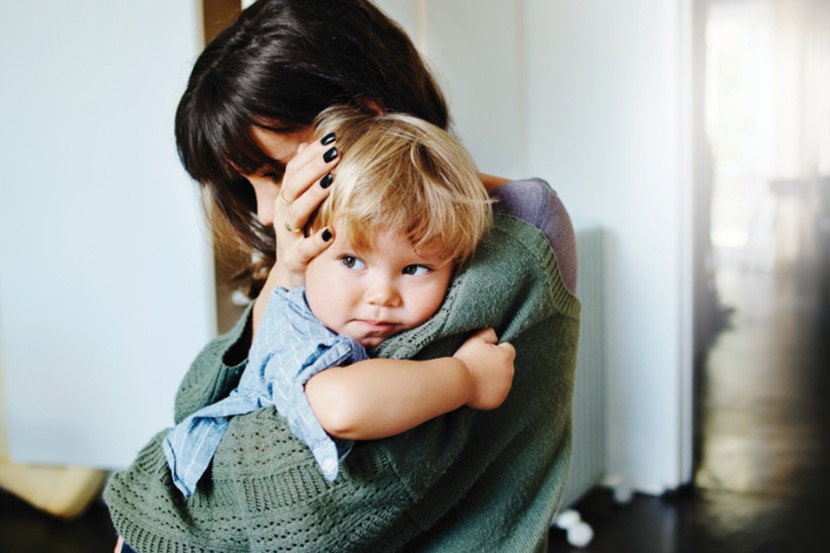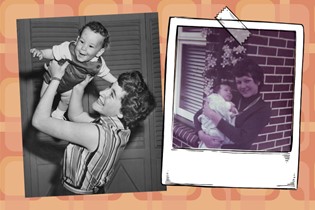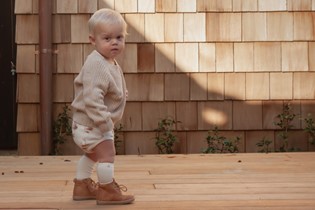Teaching kids how to manage their emotions

Teaching kids how to manage their emotions starts with more self-awareness of our own, writes Miriam McCaleb.
The poet Robert Frost wrote, “The best way out is always through”. This is true of many things: from the mundanity of emptying the dishwasher to the complexity of negotiating our inner emotional lives. It’s wise advice when it comes to supporting the emotional development of our children too.
As children move through typical development, it’s normal that they will experience a range of emotions. Dr Margot Sunderland is a British child psychologist, child mental health expert and an award-winning author. In her exceptional book The Science of Parenting, she explains how we’re born with the ability to feel only the simplest of emotions, including rage, fear and distress. Over time we develop the ability to feel all the nuanced feelings in between. That is, we gradually learn how to mix those colours into the limitless emotional shades that describe the masses of varied feelings we all experience. Melancholy. Frustration. Joy. Excitement. Anxiety. Merriment. Pensiveness. They’re all in there, they just take a little time to develop.
A BABY'S FIRST EMOTIONS
But those first emotions – the deep feelings that are there from the start – well, feeling those is as natural as blinking. A tiny baby in love with the feeling of being cuddled close to Mum is going to express her rage, fear and/or distress if she has to leave those arms to be clicked into her carseat. That’s only natural! It’s not naughtiness or wilfulness to express those emotions, it’s a perfectly reasonable reaction.
The flip side of that interaction lies with the dear Mama who is trying hard to do the right thing as she gently slides Baby into the carseat. How frustrating, how disappointing, how infuriating to be met with angry tears when all she’s trying to do is keep her baby safe. So it’s also perfectly reasonable that Mum has her own emotional reaction in that moment.
The emotions are normal and reasonable. It’s what we do with the emotions that really counts. Again, an understanding of basic brain function can help to make sense of this story.
REGULATING EMOTIONS
As you might already know, our brains develop in a hierarchical way, from simple to complex. I like American psychiatrist Dr Bruce Perry’s analogy of a layer cake – the idea that we have to bake the bottom layer before we can add the next. One of the key messages of this analogy is the idea that, as children, we bake our emotion layer before we bake our logical layer. That is, we experience emotion before we learn to regulate, contain or manage those emotions.
As babies, we learned to regulate our emotions by having our emotions regulated by our good-enough parent, again and again. When we soothe our babies, rock them gently and speak to them kindly, we allow them to piggyback our psychobiological state and get back to a place of calm. We are the metronome, ticking consistently, so that when they get out of rhythm they can get back to the beat by feeling and witnessing our calm and steady groove.
FEELING OUT OF WHACK
Which is all very well when we’re in a calm state. But what about when our own internal metronome is feeling a little erratic? It can be really hard to project zen mama vibes amidst the sleep-deprivation, domestic chaos and other adjustments of parenthood – let alone the dramas of the wider world! So how do we model regulation if we ourselves are feeling dysregulated?
I sometimes describe dysregulation as the feeling of being ‘out of whack’. It’s important to remember that there are biological realities that help to keep us ‘in whack’. Drink plenty of water. Eat regular, healthy, protein-rich snacks. Go for a walk in the fresh air. Avoid media that stirs you up. Take deeper breaths. Rest whenever you can. (I know – it can feel like a slap in the face to tell an already tired parent to get some sleep. But seriously, if you can… get some sleep!)
When we tend to those biological basics, we are more likely to be able to engage our rational brains. It’s our mighty prefrontal cortex that enables us to think logically about our feelings and to resist acting out as a result of those feelings, and access to our cortex is improved when our biological systems send messages of satiation.
For example: I might want to yell at my family when they’re slow to the table and dinner is getting cold – y’know, the dinner I have just spent ages preparing. Believe me, I might reeeeally want to yell at them in that moment, but my logical mind knows that this will not improve things. Whether or not I have the capacity to obey that higher, logical, cortical brain is largely influenced by that regulatory story. How hungry am I? How tired am I? Am I already stressed by deadlines or budgets? Is this really about the wilting of the stir fry or is it about me feeling underappreciated?
THE GOOD ENOUGH PARENT
Here’s where I return to the ‘good-enough parent’ I mentioned earlier. The academic literature reminds us that we don’t have to get it right every time in order to be effective. Parenting can be such blimmin’ hard work, nobody is Sister Sunshine every minute of the day, and friends, that is absolutely all okay.
What matters is to strive for ‘good enough’. A good enough parent will lose her cool at times, but she’ll have the wherewithal to apologise later. She’ll recognize the storm cloud of emotion brewing, and that it’s a cue to pause.
...AND BREATHE
Just for a moment. Whether you’re about to retrieve a hot dish from the oven or set the table with a grumpy clatter (am I the only one who does that?), just pause. Breathe in, breathe out: and notice your body.
Where are the feels? Tense lips? Raised shoulders? Churning stomach? Our bodies have so much valuable information for us if we just give them a moment’s attention. In a culture where it’s acceptable (even encouraged!) to distract, numb and ignore our bodies and feelings to the detriment of our collective mental health, we’re well-advised to check in with those bodies and feelings. Deliberately.
One night as I was stomping around my kitchen (I know, I’m the worst!), I took a moment to see what was up. I stopped, breathed and noticed that there was a churning in my tummy. I took another breath and thought, “Why am I so short-fused with everyone right now? I’m being really grumpy with the fam and they’re not being any more annoying than usual!” As I breathed, I noticed, “My body doesn’t feel angry. My stomach feels like it does when I’m worried. My body is telling me I’m anxious about something.”
SELF REFLECTION
Moments later, I had it. I was actually anxious about something, I just hadn’t allowed myself to acknowledge it. Earlier that day, I’d sent work to a new colleague and I was probably keener to impress them than I wanted to admit! I hadn’t heard back from them yet, and my subconscious mind had been chewing on that while my busy hands tried to get dinner on the table. For my slow-to-arrive family! Yes, here was a perfect storm of maternal grumpiness!
Now, this whole inner exchange didn’t take long. It was only about ten seconds from the time I noticed I was stomping and clattering my way around the kitchen, paused, breathed and then felt – yes, with my eyes closed. When I opened them, I had more patience for myself, and therefore for my whānau. By giving ourselves a microsecond of compassion – noticing our bodies and acknowledging our emotions – we become better equipped to act intentionally.

THE ART OF IDENTIFYING OUR EMOTIONS
It takes practice, and I’m a bit of an old lady so I’ve been doing this for years. This habit of paying attention to our bodies in order to identify our emotions might take a little longer as you get used to it. But friends, it is such a worthwhile habit, one worthy of practice.
Even better, you can describe the process to your little ones.
“Oh, I’m feeling stompy. Let me just put down this washing basket, take a couple of deep breaths and see what my body tells me. Woah, my shoulders are up around my ears! I’m feeling tense! I’m going to do a few shoulder rolls and notice that everything is okay. Right. That’s a bit better! Now I’ll hang that load of washing.”
It’s useful to say it out loud! Use your words to identify bodily connection. It helps children to express themselves when we name our own emotions. This is a skill with measurable benefits: recent work by researchers at the University of Sydney and Oxford University concluded that “understanding emotions is nearly as important as IQ for students’ academic success”.
It’s also perfectly normal for parents to struggle sometimes, as they deal with their child’s sadness, anger or overexcitement. Witnessing the struggle of our little ones can feel almost unbearable at times. A lovely mum I know said, “It’s easier to feel sad and disappointed yourself than it is to see your children feeling sad, disappointed, let down or unhappy”. Another friend told me she finds it “hard to be the grown-up when my instinct is to just wish my son an impossible eternal happiness”.
A BUTTERFLY'S STRUGGLE
There’s a story that applies here that goes something like this: a child is watching a butterfly struggle as it attempts to wiggle its way out of a chrysalis. The child longs to help the butterfly, to peel the chrysalis away and lessen the struggle. Luckily, a grandparent is on hand to explain that it’s essential for the butterfly to struggle its way out because this process strengthens the butterfly’s wings. Without the struggle, the butterfly would never fly.
Maybe we don’t like witnessing kids’ emotions because of what it triggers in ourselves. This is especially true for parents who aren’t comfortable experiencing their own ebbing and flowing emotions. Maybe we were shamed for getting angry or mocked for being sad, by unskilful or uncaring people in our own childhoods. If this sounds like you, I prescribe nurturing self-care, the loving relationships of compassionate friends and perhaps therapeutic support so you can unpack this notion with a trained professional.
Being able to accept our emotions will help us to work toward compassion for children as they learn to accept theirs. This will upskill us to be able to act as what my friend, parent educator Nathan Wallis, calls being an “emotion coach”.
It’s time well spent to work toward that place of understanding emotions. As American psychologist Dr Rick Hanson would say: “Besides being good for other people, strengthening the ‘muscle’ of the heart calms your body, protects its immune system, lifts your mood and evokes caring from others.”
Let’s feel all our own feels, and support our kids to do so too.
Miriam McCaleb lives in a house full of feelings, with her husband and two daughters in North Canterbury. She’s a researcher, writer, and children’s advocate who believes in the power of belly laughs, well-timed snacks and the occasional therapeutic cry. Come visit her at baby.geek.nz.

AS FEATURED IN ISSUE 50 OF OHbaby! MAGAZINE. CHECK OUT OTHER ARTICLES IN THIS ISSUE BELOW

















